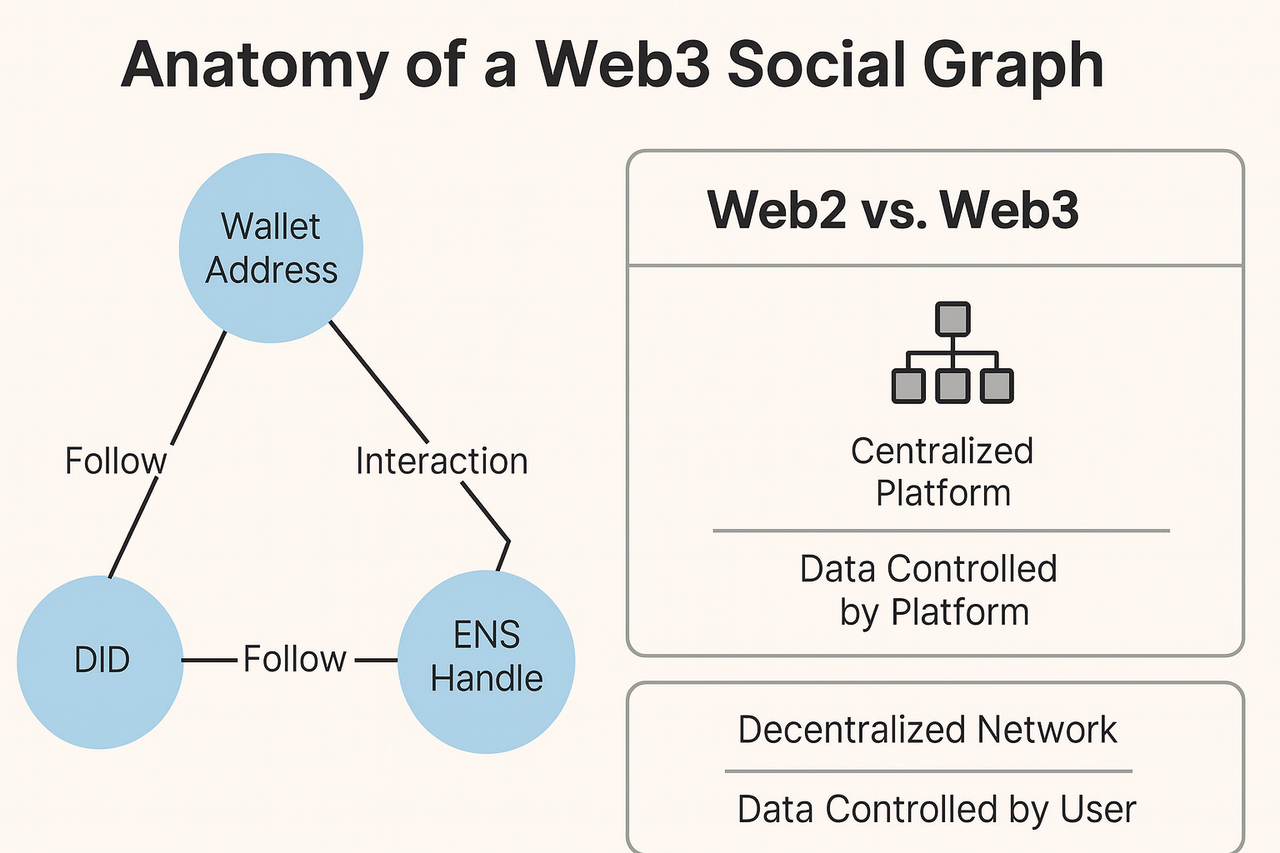Foundations of Web3 Social Graphs
Explains what a social graph is and how Web3 changes its structure, ownership, and portability. Covers the importance of decentralization, interoperability, and user control, as well as the technical elements that make Web3 social graphs possible.
What Is a Web3 Social Graph?

A social graph is a conceptual mapping of relationships among users, usually represented as nodes (users or entities) and edges (connections or interactions). This representation has been foundational in social networking since long before Web3. It gained mainstream resonance when Facebook and other platforms leveraged their internal social graphs to drive engagement and content personalization.
In Web3, the social graph undergoes a fundamental transformation. Instead of residing within a closed, centralized system, the Web3 social graph becomes distributed and user-centric. Each individual controls their connections, identity, and activity, and that information is accessible across platforms and applications, not restricted to a single walled garden. This shift restores data ownership to individuals, allowing them to move seamlessly between interfaces while retaining their relationships and history. The Web3 social graph breaks down the platform silos that characterize Web2 and ensures transparency and resilience through decentralized, immutable systems.
Why Web3 Social Graphs Matter
The significance of Web3 social graphs lies in rebalancing power and governance. In traditional systems, centralized platforms monopolize user data, determining its usage, display, and monetization. Users have limited agency beyond the boundaries of each platform, often forgetting their posts or connections cannot move with them when they leave. Web3 reverses this by giving individuals sovereign control over their own data, enabling them to grant and revoke access and even monetize interactions themselves. That ability transforms passive users into empowered actors in their own social networks.
Another critical advantage is interoperability. In Web2, social connections are confined to specific networks. Web3 social graphs bridge that fragmentation, allowing relationships to persist across interfaces and applications. This continuity enriches user experience by enabling consistent identity and community presence across diverse tools and platforms. Finally, decentralization offers censorship resistance and data integrity. There is no single point of failure or control; content and identities remain accessible even if one client or service goes offline.
Core Technical Elements of Web3 Social Graphs
At the technical core of Web3 social graphs are wallet addresses, decentralized identifiers (DIDs), ENS handles, and blockchain-based records. Wallet addresses and DIDs provide unique, verifiable identities that users control. These identifiers anchor social actions and connections to on-chain or cryptographically authenticated states, enabling portability and security across applications. ENS handles or similar domain-linked identity systems offer human-readable names to these otherwise complex identifiers, facilitating usability without sacrificing decentralization or ownership.
Layered on top of identity are storage and communication systems. Decentralized ledgers record actions such as follows, posts, or likes, anchoring them permanently and verifiably to the user’s identity. Complementing the ledger are decentralized storage solutions such as IPFS, which host content in a distributed, content-addressable manner, separating content persistence from any single server. This architecture supports transparency while preserving users’ ability to manage and share their own data across platforms. Large media payloads are typically stored off-chain (e.g., IPFS/Arweave), while on-chain entries anchor references, permissions, and provenance.
The Evolution from Web2 to Web3 Social Graphs
In Web2, social graphs are tightly controlled by centralized entities. Each platform maintains its own private graph, and users must rebuild their networks when switching platforms. Additionally, those platforms exploit user data for targeted advertising and platform leverage. Web3 social graphs resolve these issues by decentralizing ownership and enabling portability. Users no longer need to rebuild relationships; instead, they carry their graph with them, and often choose how and why they share that information.
This transition also reflects a broader philosophical shift toward interoperability and user autonomy on the internet. Where Web2 prioritized convenience and reach at the cost of privacy and control, Web3 emphasizes sovereignty balanced with access. Interoperability now stems from shared, open protocols rather than closed APIs, enabling richer and more diverse ecosystems of social applications.





